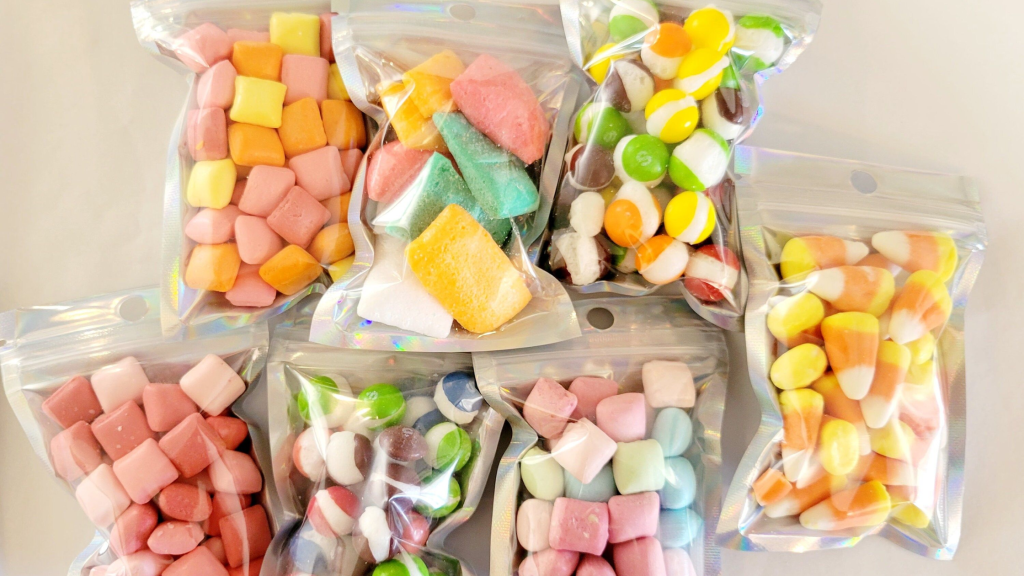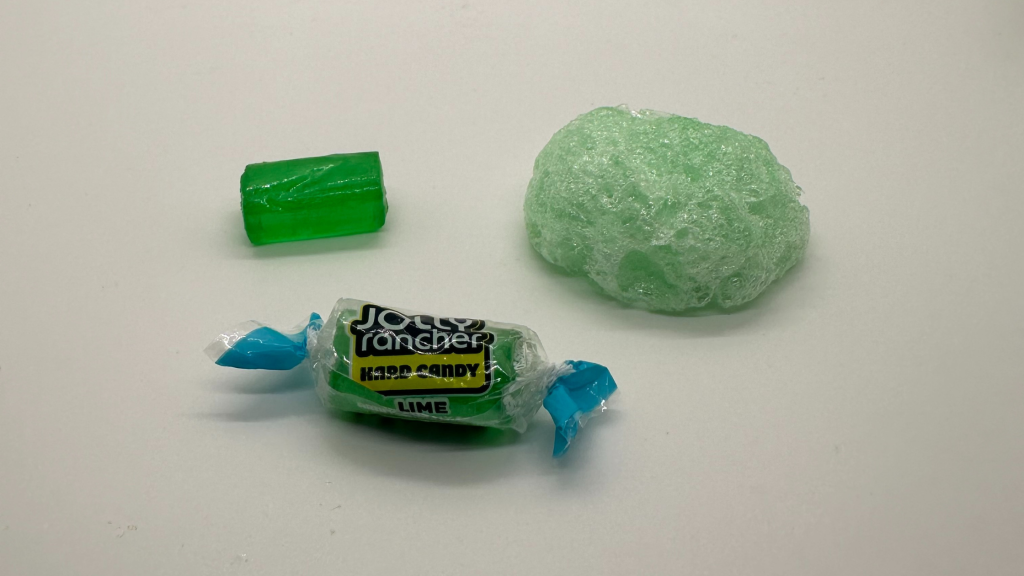Where can you find freeze-dried candy?
It’s hard to scroll TikTok or stroll a food market without seeing a bag of freeze-dried candy. Brightly puffed Skittles, crunchy marshmallows, and air-light gummies have become social media sensations. The appeal is instant: these candies are light, loud, and addictive in texture. When freeze-dried, chewy sweets turn crisp, sour flavors pop harder, and sweetness feels more intense.
Freeze-dried candy thrives on novelty. It offers a sensory twist that’s halfway between a classic treat and a space-age snack. The lightness makes every bite dramatic, and the long shelf life turns homemade or artisanal candy into viable e-commerce products. This combination of entertainment, portability, and flavor intensity explains why freeze-dried candy has moved from niche maker shops into something that both small businesses and large manufacturers now explore.
According to Food Ingredients First (2025), the freeze-dried category saw double-digit growth across North America and Europe last year, with candy emerging as one of its fastest-expanding product types. Interest is also surging in Asia and the Middle East as consumers seek indulgent snacks made with fewer preservatives and more natural ingredients.
But as demand grows, so does the conversation around how candy is made and whether freeze drying is the best method for long-term scalability.

Where to find freeze-dried candy today
One of the best things about this trend is accessibility. Freeze-dried candy isn’t confined to upscale stores anymore; it’s turning up everywhere from craft markets to mail-order shops. Here’s where consumers can find it.
Online platforms
Most people encounter freeze-dried candy through e-commerce. Amazon, Etsy, and specialty sellers like Galaxy Bites or Freeze Dried America list hundreds of options shipped directly from small producers. Many of these candies are produced using home or semi-commercial freeze dryers. These businesses often customize flavors, mix varieties, or infuse extra fruit powders to add unique colors and taste profiles.
Boutique confectioners and gourmet markets
Gourmet candy brands have caught on to the viral nature of the trend. Independent confectioners now sell locally made freeze-dried favorites in pre-packed pouches. From puffed taffy to crunchy chocolate-covered caramels, the category is evolving fast. You’ll often find these candies in the “local artisan” or “novelty” sections of food stores.
Candy subscription boxes and influencer drops
Startups are using subscription models to ship curated assortments of freeze-dried candy, often featuring limited-edition or seasonal mixes. TikTok and Instagram creators frequently bundle branded versions for direct sale, turning viral appeal into reorders.
Specialty bulk retailers
In recent months, even niche bulk suppliers and outdoor outfitters have embraced the category. Retailers that once sold freeze-dried fruit or camping meals now dedicate aisles to candy variations that appeal to both on-the-go consumers and impulse buyers.
The availability has never been higher but growing popularity also reveals the limitations of current processing technology.
The limitations of commercial freeze drying for candy
Freeze-dried candy looks effortless, but behind the scenes, the technology brings several production challenges. While the process yields impressive texture and shelf stability, it is also energy-intensive and slow by industrial standards.
Behind the consumer excitement, the “freeze drying” process for candies is a bit of a misnomer. Unlike traditional lyophilization (which freezes products and sublimates water) candies don’t actually freeze due to their high sugar and low water content.
Instead, the process for freeze-dried candies relies primarily on vacuum pressure and heat conduction, not true freezing or ice sublimation. This can create operational challenges:
- Cycles take 2-3 hours and vary widely according to candy density and sugar profile.
- High sugar and gelatin content leads to unpredictable texture: some pieces puff up dramatically, while others collapse. Brittle coatings or sensitive fillings are especially vulnerable to heat, resulting in cracks or inconsistent texture.
While “freeze-dried” candies deliver novel crunch and intense flavor, behind the scenes operators face a unique set of technical limitations and production quirks.
A new approach: microwave dehydration for confectionery
Here’s where technology can make a big difference. Freeze drying may have started the crunchy candy craze, but it isn’t the only way to achieve that satisfying light texture and vivid color. Microwave dehydration under vacuum (the technology behind EnWave’s REV™ systems) offers a faster, cleaner, and more efficient path to the same result.
REV™ uses uniform microwave energy combined with vacuum pressure to remove moisture at lower temperatures than traditional dehydration, preserving both structure and flavor. In candy, it allows sugar-based confections to dry evenly without the cracking or dunking common in freeze drying. Candy manufacturers can achieve crisp, puffed, or chewy textures in minutes, not days, while protecting color and preventing stickiness.
Tests performed at EnWave’s pilot facility with candies such as Skittles, Jolly Ranchers, Starburst, and taffy demonstrated how REV™’s low thermal profile can create beautifully expanded structures and intense flavor while maintaining bright, glossy appearance. Because the process operates at lower energy input, it significantly reduces production time and operating costs crucial for companies looking to scale.
These are key benefits of microwave dehydration in confectionery:
- Speed: Drying cycles can be completed in minutes compared to the lengthy cycles required by freeze drying.
- Energy efficiency: Lower energy consumption means reduced environmental footprint and cost savings.
- Texture control: Manufacturers can fine-tune airflow, power, and vacuum levels to design specific textures from airy crunch to gentle chew.
- Nutrient and color retention: The short, precise drying cycle minimizes oxidation and caramelization, keeping color bright and natural.
- Scalability: REV™ units range from laboratory-scale systems for R&D to industrial continuous lines for commercial food drying.
When compared against commercial freeze drying, REV™ technology bridges performance and practicality delivering cleaner products faster and more sustainably.

Why texture innovation matters in today’s candy market
Texture defines modern confectionery innovation. Candy lovers seek experiences: how something crunches, melts, or bursts matters as much as its taste. A 2025 Mintel Snack Trends report shows that over 60% of consumers view “texture and sensory uniqueness” as reasons to try new sweets.
Freeze drying brought a revolution in mouthfeel, but newer drying technologies open creative space beyond crispiness alone. Microwave drying lets makers create hybrid experiences: fruit gummies that are slightly chewy yet have a satisfying snap, or aerated chocolate clusters that stay light but don’t crumble.
REV™ systems excel in these applications because they can dry from the inside out evenly, preventing surface hardening. This allows production of multilayered candies for example, fruit fillings inside a crunchy shell without overprocessing.
For brands that prioritize clean-label product development, this control helps avoid added stabilizers or coatings traditionally required to maintain texture.
Faster production, better energy use, and consistent results
From a commercial food processing perspective, efficient throughput is critical. Every hour saved in drying translates to lower cost per unit and higher throughput for growing brands.
Freeze drying systems often require not just time but pre-freezing, careful tray loading, and defrosting maintenance between batches. With microwave dehydration, a continuous or semi-continuous process eliminates downtime. Configurations can run up to 22 hours per day, supporting commercial food drying at serious scale.
Energy use studies show microwave dehydration’s energy consumption can be less than half of equivalent freeze drying cycles. The process’s reduced thermal stress enhances product uniformity, meaning fewer rejected batches.
These operational differences directly impact profitability and sustainability two factors that modern manufacturers can’t afford to ignore.
The commercial perspective
Whether you are a candy start-up or part of a global CPG brand, the business case for efficient dehydration comes down to quality and cost balance. Commercial freeze drying remains the standard for long-term preservation, but it carries higher energy usage and slower cycle times. For candy specifically, these constraints raise the per-unit production cost and limit flexibility for small-batch seasonal runs or new launches.
Microwave drying equipment, by contrast, opens the market to a continuum between artisanal creativity and industrial efficiency. Modular REV™ systems grow alongside brand needs, supporting both small R&D production lines and high-volume output for established manufacturers.
Additionally, microwave drying’s lower environmental footprint contributes to sustainability goals increasingly tracked across food tech and confectionery supply chains.
In short, technology is no longer just a behind-the-scenes process it’s part of a brand’s identity, shaping claims like “energy-saving,” “faster production,” and “fewer additives.”
Innovation meets experience
Candy culture thrives on reinvention. What started as nostalgia-driven freeze-dried Skittles videos has grown into a broader shift toward novel snacking experiences that blend indulgence with food science.
As consumers look for craveable treats with fewer additives and authentic flavors, manufacturers are rethinking not just ingredients but also the technology behind them. Those willing to adopt emerging drying methods are finding new ways to balance fun, flavor, and functionality.
EnWave’s microwave dehydration pushes this evolution forward. It helps producers craft sensory-rich, shelf-stable treats while conserving energy and maintaining natural color and aroma. This is the next frontier of food innovation, combining efficiency with creativity to meet consumer curiosity head-on.
Bringing innovation to market with EnWave
Whether you’re exploring dried candy, fruit snacks, or double-texture confections, the right technology transforms what’s possible. EnWave partners with brands of all sizes to test concepts, prototype, and scale with confidence.
Through pilot facilities, global licensing, and the REVworx toll drying service, our team supports the full journey from idea to commercial line setup. Brands can develop distinctive dried candy or snack products that stand out in both taste and texture.
If you’re ready to move beyond the limits of traditional freeze drying and discover a faster, smarter alternative, explore what microwave dehydration can do for your confectionery line.
Learn more about our technology, solutions, and commercial partnerships at enwave.net or contact us.
Further Reading
- Food Ingredients First, “Global clean label market trends”: https://www.foodingredientsfirst.com/news/global-clean-label-trends-consumer-preferences-2025.html
- EnWave Corporation, “Freeze-Drying vs. Dehydrating – What’s the Difference?”: https://www.enwave.net/freeze-drying-vs-dehydrating-whats-the-difference/
- Rocket Krunch, “Difference Between Freeze Dried Candy and Dehydrated Candy”: https://www.rocketkrunch.com/blogs/topics/difference-between-freeze-dried-candy-and-dehydrated-candy
- Get Frizzle, “Freeze-Dried vs Dehydrated: What’s the Difference and Why It Matters for Candy”: https://getfrizzle.com/blogs/blogs/freeze-dried-vs-dehydrated-what-s-the-difference-and-why-it-matters-for-candy
- Space-Man Canada, “Freeze-Dried vs Dehydrated Candy: Key Differences”: https://space-man.ca/blogs/spaceblog/freeze-dried-vs-dehydrated-candy
- National Library of Medicine, “Comparison of Traditional and Novel Drying Techniques”: https://pmc.ncbi.nlm.nih.gov/articles/PMC7554907/


